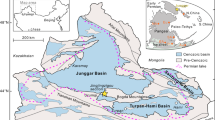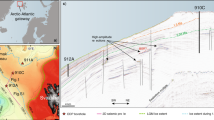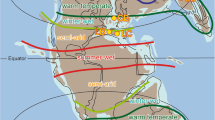Abstract
The Palaeocene–Eocene thermal maximum (PETM), a period of intense, global warming about 55 million years ago1, has been attributed to a rapid rise in greenhouse gas levels, with dissociation of methane hydrates being the most commonly invoked explanation2. It has been suggested previously that high-latitude methane emissions from terrestrial environments could have enhanced the warming effect3,4, but direct evidence for an increased methane flux from wetlands is lacking. The Cobham Lignite, a recently characterized expanded lacustrine/mire deposit in England, spans the onset of the PETM5 and therefore provides an opportunity to examine the biogeochemical response of wetland-type ecosystems at that time. Here we report the occurrence of hopanoids, biomarkers derived from bacteria, in the mire sediments from Cobham. We measure a decrease in the carbon isotope values of the hopanoids at the onset of the PETM interval, which suggests an increase in the methanotroph population. We propose that this reflects an increase in methane production potentially driven by changes to a warmer1,6 and wetter climate7,8. Our data suggest that the release of methane from the terrestrial biosphere increased and possibly acted as a positive feedback mechanism to global warming.
This is a preview of subscription content, access via your institution
Access options
Subscribe to this journal
Receive 51 print issues and online access
$199.00 per year
only $3.90 per issue
Buy this article
- Purchase on Springer Link
- Instant access to full article PDF
Prices may be subject to local taxes which are calculated during checkout


Similar content being viewed by others
References
Zachos, J. C. et al. A transient rise in tropical sea surface temperature during the Paleocene–Eocene Thermal Maximum. Science 302, 1551–1554 (2003)
Dickens, G. R. Rethinking the global carbon cycle with a large, dynamic and microbially mediated gas hydrate capacitor. Earth Planet. Sci. Lett. 213, 169–183 (2003)
Sloan, L. C., Walker, J. C. G., Moore, T. C., Rea, D. K. & Zachos, J. C. Possible methane-induced polar warming in the early Eocene. Nature 357, 320–322 (1992)
Sloan, L. C. & Pollard, D. Polar stratospheric clouds: A high latitude warming mechanism in an ancient greenhouse world. Geophys. Res. Lett. 25, 3517–3520 (1998)
Collinson, M. E., Hooker, J. J. & Gröcke, D. R. in Causes and Consequences of Globally Warm Climates in the Early Paleogene (eds Wing, S. L., Gingerich, P. D., Schmitz, B. & Thomas, B.) 333–349 (Geol. Soc. Am. Special Paper 369, Boulder, Colorado, 2003)
Kennett, J. P. & Stott, L. D. Abrupt deep-sea warming, palaeoceanographic changes and benthic extinctions at the end of the Palaeocene. Nature 353, 225–229 (1991)
Bowen, G. J., Beerling, D. J., Koch, P. L., Zachos, J. C. & Quattlebaum, T. A humid climate state during the Palaeocene/Eocene thermal maximum. Nature 432, 495–499 (2004)
Crouch, E. M. et al. The Apectodinium acme and terrestrial discharge during the Paleocene–Eocene thermal maximum: new palynological, geochemical and calcareous nannoplankton observations at Tawanui, New Zealand. Palaeogeogr. Palaeoclimatol. Palaeoecol. 194, 387–403 (2003)
Zachos, J., Pagani, M., Sloan, L., Thomas, E. & Billups, K. Trends, rhythms, and aberrations in global climate 65 Ma to present. Science 292, 686–693 (2001)
Collinson, M. E., Steart, D. C., Scott, A. C., Glasspool, I. J. & Hooker, J. J. Episodic fire, run-off and deposition at the Palaeocene–Eocene boundary. J. Geol. Soc. Lond. 164, 87–97 (2007)
Magioncalda, R. et al. L’excursion isotopique du carbone organique (δ13C) dans les paléoenvironnements continentaux de l’intervalle Paléocène/Eocène de Varengeville (Haute-Normandie). Bull. Soc. Geol. Fr. 172, 349–358 (2001)
Steurbaut, E. et al. Palynology, palaeoenvironments, and organic carbon isotope evolution in lagoonal Paleocene–Eocene boundary settings in North Belgium. GSA Spec. Pap. 369, 291–317 (2003)
Xie, S. C., Pancost, R. D., Yin, H. F., Wang, H. M. & Evershed, R. P. Two episodes of microbial change coupled with Permo/Triassic faunal mass extinction. Nature 434, 494–497 (2005)
Eglinton, G. & Hamilton, R. J. Leaf epicuticular waxes. Science 156, 1322–1334 (1967)
Rohmer, M., Bouviernave, P. & Ourisson, G. Distribution of hopanoid triterpenes in prokaryotes. J. Gen. Microbiol. 130, 1137–1150 (1984)
Hartner, T., Straub, K. L. & Kannenberg, E. Occurrence of hopanoid lipids in anaerobic Geobacter species. FEMS Microbiol. Lett. 243, 59–64 (2005)
Pancost, R. D., Baas, M., van Geel, B. & Damste, J. S. S. Response of an ombrotrophic bog to a regional climate event revealed by macrofossil, molecular and carbon isotopic data. Holocene 13, 921–932 (2003)
Collister, J. W., Summons, R. E., Lichtfouse, E. & Hayes, J. M. An isotopic biogeochemical study of the Green River oil-shale. Org. Geochem. 19, 265–276 (1992)
Ruble, T. E., Bakel, A. J. & Philp, R. P. Compound-specific isotopic variability in Uinta Basin native bitumens—paleoenvironmental implications. Org. Geochem. 21, 661–671 (1994)
Schouten, S. et al. Molecular organic tracers of biogeochemical processes in a saline meromictic lake (Ace Lake). Geochim. Cosmochim. Acta 65, 1629–1640 (2001)
Inubushi, K. et al. Factors influencing methane emission from peat soils: Comparison of tropical and temperate wetlands. Nutrient Cycling Agroecosyst. 71, 93–99 (2005)
Christensen, T. R. et al. Factors controlling large scale variations in methane emissions from wetlands. Geophys. Res. Lett. 30 1414 doi: 10.1029/2002GL016848 (2003)
Steart, D. C., Collinson, M. E., Scott, A. C., Glasspool, I. J. & Hooker, J. J. The Cobham Lignite Bed: the palaeobotany of two petrographically contrasting lignites from either side of the Paleocene–Eocene carbon isotope excursion. Acta Palaeobot 47, (1)109–125 (2007)
Schmitz, B. & Pujalte, V. Abrupt increase in seasonal extreme precipitation at the Paleocene–Eocene boundary. Geology 35, 215–218 (2007)
Gibson, T. G., Bybell, L. M. & Mason, D. B. Stratigraphic and climatic implications of clay mineral changes around the Paleocene/Eocene boundary of the northeastern US margin. Sedim. Geol. 134, 65–92 (2000)
Zachos, J. C. et al. Rapid acidification of the ocean during the Paleocene–Eocene thermal maximum. Science 308, 1611–1615 (2005)
Pagani, M. et al. Arctic hydrology during global warming at the Palaeocene/Eocene thermal maximum. Nature 442, 671–675 (2006)
Maslin, M. A. & Thomas, E. Balancing the deglacial global carbon budget: the hydrate factor. Quat. Sci. Rev. 22, 1729–1736 (2003)
Kurtz, A. C., Kump, L. R., Arthur, M. A., Zachos, J. C. & Paytan, A. Early Cenozoic decoupling of the global carbon and sulfur cycles. Paleoceanography 18, doi:10.1029/2003PA000908. (2003)
Sluijs, A. et al. Subtropical arctic ocean temperatures during the Palaeocene/Eocene thermal maximum. Nature 441, 610–613 (2006)
Gradstein, F. M., Ogg, J. G. & Smith, A. G. (eds) A Geologic Time Scale 2004 (Cambridge University Press, Cambridge, 2004)
Ellison, R. A., Ali, J. R., Hine, N. M. & Jolley, D. W. in Correlation of the Early Paleogene in Northwest Europe (eds Knox, R. W. O’B., Corfield, R. M. & Dunay, R. E.) 185–193 (Geol. Soc. Lond. Special Publication 101, 1996)
Bujak, J. P. & Brinkhuis, H. in Late Paleocene–Early Eocene Climatic and Biotic Events in the Marine and Terrestrial Records (eds Aubry, M.-P., Lucas, S. G. & Berggren, W. A.) 277–295 (Columbia University Press, New York, 1998)
Powell, A. J. in A Stratigraphic Index of Dinoflagellate Cysts (ed. Powell, A. J.) 155–252 (Br. Micropalaeontol. Soc. Publ. Series, Chapman & Hall, London, 1992)
Grassineau, N. V. High-precision EA-IRMS analysis of S and C isotopes in geological materials. Appl. Geochem. 21, 756–765 (2006)
Acknowledgements
We thank I. D. Bull and R. Berstan of the Bristol Node of the NERC Life Sciences Mass Spectrometry Facility (LSMSF) for analytical support; Alfred McAlpine plc, AMEC and Channel Tunnel Rail Link for access to the Cobham Lignite Bed, and S. Rose for making arrangements; J. Skipper and S. Tracey for help with initial sample collection and field discussions; and L. Kump for critical comments and advice on the ideas proposed here. We acknowledge funding support for this research from the Leverhulme Trust, and studentship support for L.H. from the NERC.
Author Contributions R.D.P. and M.E.C. contributed equally to this paper. M.E.C., J.J.H. and A.C.S. initially characterized the Cobham Lignite, with I.J.G., and led the subsequent more detailed characterization of the sediments and fossils conducted by D.S.S. R.D.P. led the biomarker analyses at Bristol, with most of the preparation and analyses being conducted by D.S.S., with training and assistance from L.H. N.V.G. conducted bulk organic matter isotopic measurements. R.D.P. wrote the paper, and all authors discussed the results and commented on the manuscript.
Author information
Authors and Affiliations
Corresponding author
Ethics declarations
Competing interests
Reprints and permissions information is available at www.nature.com/reprints. The authors declare no competing financial interests.
Rights and permissions
About this article
Cite this article
Pancost, R., Steart, D., Handley, L. et al. Increased terrestrial methane cycling at the Palaeocene–Eocene thermal maximum. Nature 449, 332–335 (2007). https://doi.org/10.1038/nature06012
Received:
Accepted:
Issue Date:
DOI: https://doi.org/10.1038/nature06012
This article is cited by
-
Sustained and intensified lacustrine methane cycling during Early Permian climate warming
Nature Communications (2022)
-
Distribution of Inertinites in the Early Paleogene Lignites of Western India: On the Possibility of Wildfire Activities
Journal of the Geological Society of India (2019)
-
High temperatures in the terrestrial mid-latitudes during the early Palaeogene
Nature Geoscience (2018)
-
Seasonal variations of methane fluxes from an unvegetated tidal freshwater mudflat (Hammersmith Creek, GA)
Biogeochemistry (2013)
-
Late Paleocene–early Eocene carbon isotope stratigraphy from a near-terrestrial tropical section and antiquity of Indian mammals
Journal of Earth System Science (2013)
Comments
By submitting a comment you agree to abide by our Terms and Community Guidelines. If you find something abusive or that does not comply with our terms or guidelines please flag it as inappropriate.



